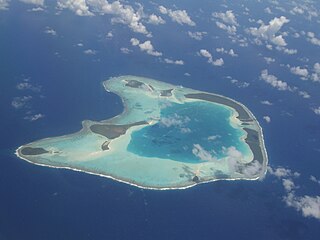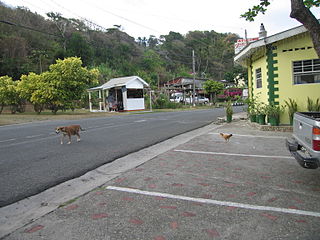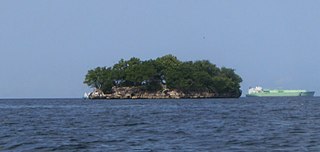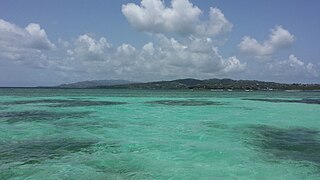
The Caribbean Sea is a sea of the Atlantic Ocean in the tropics of the Western Hemisphere. It is bounded by Mexico and Central America to the west and southwest, to the north by the Greater Antilles starting with Cuba, to the east by the Lesser Antilles, and to the south by the northern coast of South America. The Gulf of Mexico lies to the northwest.

The Red Sea is a seawater inlet of the Indian Ocean, lying between Africa and Asia. Its connection to the ocean is in the south, through the Bab el Mandeb strait and the Gulf of Aden. To its north lie the Sinai Peninsula, the Gulf of Aqaba, and the Gulf of Suez. It is underlain by the Red Sea Rift, which is part of the Great Rift Valley.

An atoll is a ring-shaped island, including a coral rim that encircles a lagoon. There may be coral islands or cays on the rim. Atolls are located in warm tropical or subtropical parts of the oceans and seas where corals can develop. Most of the approximately 440 atolls in the world are in the Pacific Ocean.

Corals are colonial marine invertebrates within the class Anthozoa of the phylum Cnidaria. They typically form compact colonies of many identical individual polyps. Coral species include the important reef builders that inhabit tropical oceans and secrete calcium carbonate to form a hard skeleton.

A coral reef is an underwater ecosystem characterized by reef-building corals. Reefs are formed of colonies of coral polyps held together by calcium carbonate. Most coral reefs are built from stony corals, whose polyps cluster in groups.

Tobago is an island and ward within the Republic of Trinidad and Tobago. It is located 35 kilometres (22 mi) northeast of the larger island of Trinidad and about 160 kilometres (99 mi) off the northeastern coast of Venezuela. It lies to the southeast of Grenada.

The Northwestern Hawaiian Islands or Leeward Hawaiian Islands are a series of islands and atolls in the Hawaiian island chain located northwest of the islands of Kauai and Niʻihau. Politically, they are all part of Honolulu County in the U.S. state of Hawaii, except Midway Atoll, which is a territory distinct from the State of Hawaii, and grouped as one of the United States Minor Outlying Islands. The United States Census Bureau defines this area, except Midway, as Census Tract 114.98 of Honolulu County. Its total land area is 3.1075 square miles (8.048 km2). All the islands except Nihoa are north of the Tropic of Cancer, making them the only islands in Hawaii that lie outside the tropics.

Speyside is a village in northern Tobago within Saint John Parish. It lies on the leeward coast, across from the island of Little Tobago, 26 km northeast of Scarborough, overlooking Tyrrel's Bay. At the census of population in 2000, the town had a population of 1100.

Stenopus hispidus is a shrimp-like decapod crustacean belonging to the infraorder Stenopodidea. Common names include coral banded shrimp and banded cleaner shrimp.

Lyme Bay is an area of the English Channel off the south coast of England. The south western counties of Devon and Dorset front onto the bay.

Crown Point is a town in southwestern Tobago, Trinidad and Tobago. It contains the A.N.R. Robinson International Airport which was formerly known as the Crown Point International Airport. It is near Store Bay, Buccoo Reef, and Pigeon Point. Crusoe Cave is located nearby.

Pigeon Point is also known as Pigeon Point Heritage Park (PPHP) and is often considered Tobago’s most beautiful beach and is home to the world famous thatch-roofed jetty which has become an internationally recognised signature of Tobago. The resort includes a long stretch of white sand beach with warm aquamarine waters. There are excellent beach facilities such as bathrooms, showers and beach-chair rentals as well as bars and a restaurant. Tourist amenities include souvenir and water-sports shops.
Sisters’ Rocks are islands in the Republic of Trinidad and Tobago in the Caribbean Sea. It is located off the northern coast of Tobago directly north of Parlatuvier. Sisters' Rock is popular for snorkeling and scuba diving. The coral reef to the landward eastern side hosts black durgons, brown chromis, creole wrasse, and dwarf angelfish.

Rock Island is a small island in Trinidad and Tobago, part of the Five Islands group of islands. It is located in the Gulf of Paria, approximately 2 kilometres off the main island of Trinidad from Point Gourde. Of the "Five Islands", which are actually made up of six different islands, Rock is the second smallest and the most western of the group.

The Caribbean is a subregion of the Americas that includes the Caribbean Sea and its islands, some of which are surrounded by the Caribbean Sea and some of which border both the Caribbean Sea and the North Atlantic Ocean; the nearby coastal areas on the mainland are often also included in the region. The region is southeast of the Gulf of Mexico and the North American mainland, east of Central America, and north of South America.

Coral aquaculture, also known as coral farming or coral gardening, is the cultivation of corals for commercial purposes or coral reef restoration. Aquaculture is showing promise as a tool for restoring coral reefs, which are dying off around the world. The process protects young corals while they are most at risk of dying. Small corals are propagated in nurseries and then replanted on the reef.


Goat Racing is a sport that originated in Buccoo, Tobago, which is part of the twin-island republic of Trinidad and Tobago. The sport has been continued by some legends in Townsville. Started in 1925 by a Barbadian, Samuel Callendar, goat racing historically occurs on the Tuesday after Easter day, which is known as 'Easter Tuesday' in Trinidad and Tobago and is an unofficial public holiday in Tobago. Today, it is called the Buccoo Goat Race Festival, which is a popular and lively event that draws thousands of spectators, mainly from Trinidad. Also part of the festival is the less popular crab racing. In crab racing, large blue crabs and their jockeys are placed in the centre of a large circle drawn in the sand and coaxed towards the circle's perimeter by their jockeys through a bamboo pole with a string attached to the crab. The first crab to breach the circle is the winner. The Buccoo Goat Race Festival is Tobago's most internationally acclaimed festival.

Lighthouse Reef is an atoll in the Caribbean Sea, the easternmost part of the Belize Barrier Reef and one of its three atolls, the other two being Turneffe Atoll and Glover's Reef. Lighthouse Reef is located about 80 kilometres (50 mi) southeast of Belize City. The atoll is of oblong shape, approximately 35 kilometres (22 mi) long from north to south, and about 8 kilometres (5.0 mi) wide. It forms a shallow sandy lagoon with an area of 120 square kilometres (46 sq mi) and a depth between 2 and 6 metres deep.

The island of Tobago has multiple coral reef ecosystems. The Buccoo Reef, the Culloden Reed and Speyside Reef are the three largest coral reef marine ecosystems in Tobago. The Buccoo Reef is a coralline reef ecosystem that is located on the southwestern region of Tobago. It is a popular ecotourism attraction where tourists can snorkel and see the coral reefs and schools of fish without diving equipment. The Trinidad and Tobago Tourism Ministry estimates that 90% of its tourists visit the Buccoo Reef while exploring Tobago. The Buccoo Reef, also known as the Buccoo Reef Complex, spans 7 km2 and has five reef flats that can reach up to 25 metres in depth. The reef complex has been designated as part of a protected Ramsar site since 2005.



















